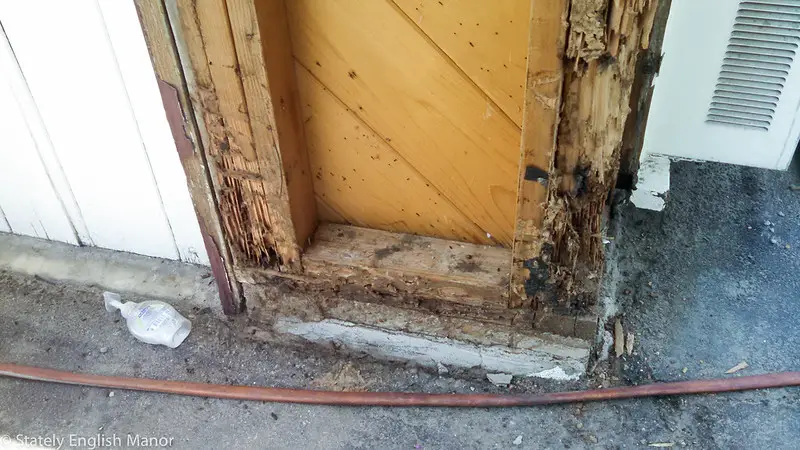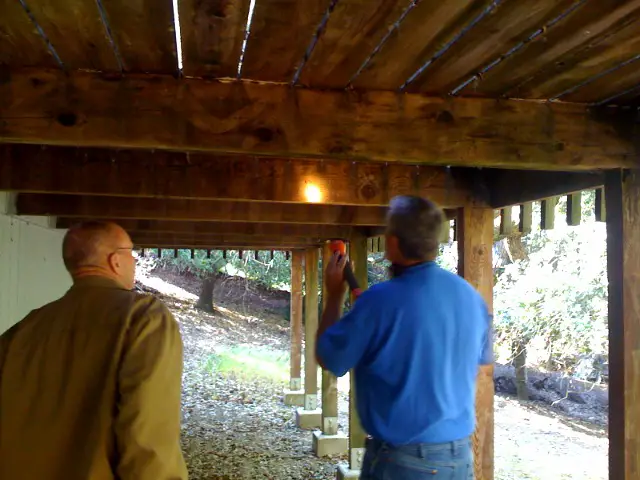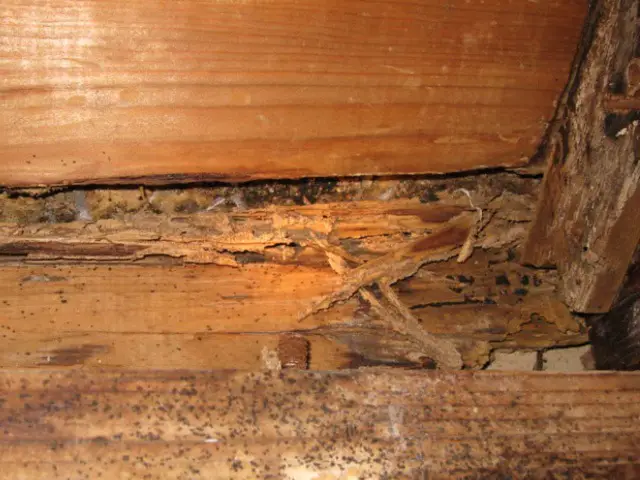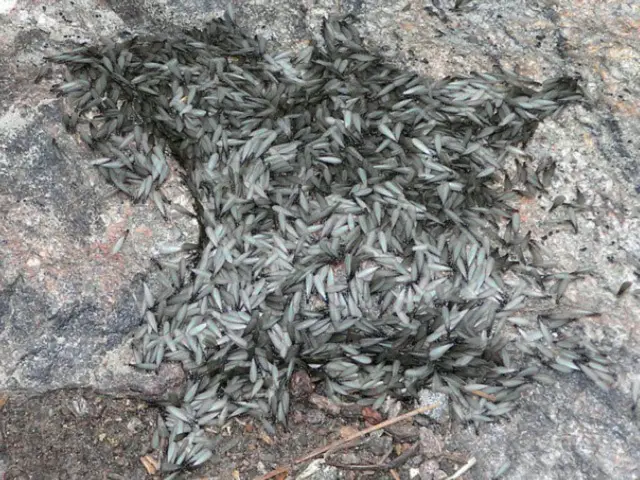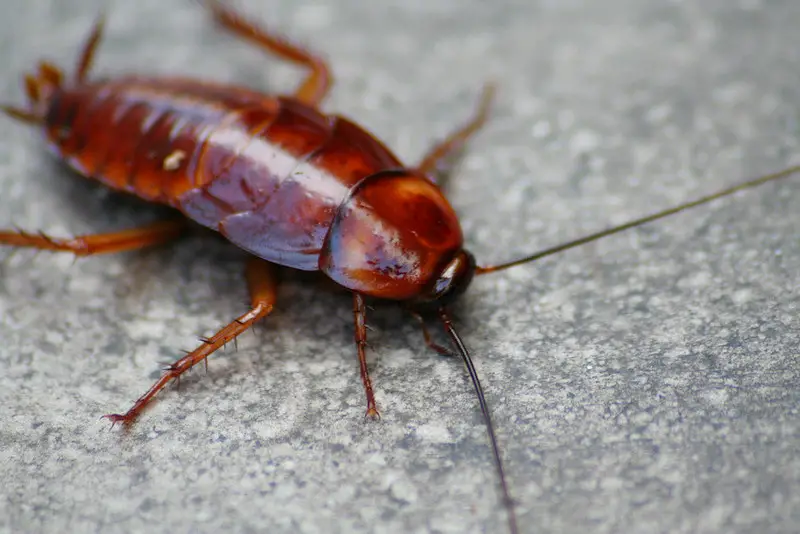Termites are a problem in all but two U.S. states. This national problem is estimated to cause more than $5 billion in property damage every year. But, the question is: “What are the early signs of termite damage?”
Early signs of termite damage are wood that sounds hollow when tapped, discolored drywall, pinpoint holes in drywall, peeling paint, buckling floorboards, and crumbling and damaged wood.
What are the early signs of termite damage?
Hollow-sounding mounds of termite pellets, flying termite swarms, piles of termite wings, wood when tapped, mud tubes around the foundation of your house, small holes in drywall, damaged wood, and maze-like patterns in wood furniture are some of the early signs of termite damage.
Related posts:
- What Are Common Termites In Florida?
- How To Prevent Termites In Texas?
- How To Prevent Termites In New York?
- How To Prevent Termites In Pennsylvania?
- How To Prevent Termites In North Carolina?
- How To Prevent Termites In Ohio?
- Is termite inspection required for an FHA loan?
- How To Prevent Termites In California?
Protecting your house before signs of termites damage your house is a great way to save money. Prevention will keep your family and property safe from termites. Termites nesting in your home for years can cause tens of thousands of dollars in damage or more. Unfortunately, this type of termite damage is not always covered by homeowners insurance.
Be proactive about preventing termite damage by periodically searching for termite signs in your home. It might also help to have a termite protection plan in place by a reputable termite control. Make sure the termite protection plan also includes an annual termite inspection service. Having this type of service in place helps to eliminate the stress of having to repair new termite damage in your house.
What are the early signs of termite infestation?
Some of the early signs of termite infestation are termite wings. Look for discarded termite wings near closed doors, windows, vent openings and other house-access points. This results from termites swarming out of their nest to mate and find a place to start a new colony. When they reach their destination, termites intentionally twist their wings off. Because once the termites arrive at your house, they will never need their wings again. Unlike ant wings which are one pair of larger front wings and the other smaller rear wings, termite wings are all the same size.
What are the early signs of termite activity?
Blisters in wood flooring is an early sign of termites in the house. The blisters can indicate termites feeding inside the wood and laminate flooring or below the floor. Subterranean termite damage looks similar to water damage.
What are the first signs of termite activity?
Wood damage is another early sign of termites in the house. This type of termite damage can be found behind and below surfaces like floors and walls. Termites constantly search for cellulose, chewing through wood, leaving behind long grooves. Unfortunately, the grooves weaken the wood, creating structural change. In addition, the honeycomb interior of the hollowed wood gives an empty sound when tapped.
Tell-Tale Signs of Termite Infestation
Pencil-sized mud tubes can signal termites in the house. Subterranean termites use mud tunnels to forage from their nest underground to their food source, often the wood frame of a home. Termites require specific humidity and temperature levels to stay alive. Termite tunnels help regulate the temperature and humidity of the termite nest, creating the ideal environment to thrive.
Drywood termites nest inside of wood. These pests create galleries that they like to keep clean while tunneling and eating the wood they’re infesting. To keep them clean, termites make kick-out holes where they drop their excrement. And since drywood termites eat wood, their droppings look like wood. The mounds of pellets serve as a sign of termite activity in your house. The mounds of pellets look like ground coffee or sawdust, indicating drywood termite infestation.
Unfortunately, no sign of termites doesn’t mean there aren’t termites in the house. Termite damage can go unnoticed for a long time. And by the time you notice, the termites could have done a lot of structural damage in your home. That’s why you should have a termite inspection before signs of termite activity.
Related posts:
- How To Prevent Termites In Illinois?
- How To Prevent Termites In Florida?
- Can You Get Rid Of Termites Without Tenting?
- How To Prevent Termites In Michigan?
- How To Prevent Termites In Georgia?
- What Does A Termite Nest Look Like?
- Is termite inspection required for a VA loan?
Termites and damaged wood
It takes not only a trained eye but an honest person to help you determine what has caused damage to wood. There are subtle distinctions between termite damage, carpenter ant damage, carpenter bees, wood-boring beetles, moisture/wood rot, fungus etc. Sometimes a person with good intentions but without appropriate experience will give a wrong diagnosis.
Unfortunately, a dishonest person acting under the guise of being a termite control professional may steer you toward recommending an expensive but perhaps unnecessary remedy. Get more than one opinion before you decide on termite treatment for your house.
Signs of subterranean termites in your house
Subterranean termites are the most common type of termite in the U.S. Before you can get rid of termites, it’s important to look for signs of termites in your house. They live in underground termite nests, getting moisture from the soil and eating cellulose found in plant matter and wood. This is why they can often be found in any wooden structure close to the ground, e.g., sills, porches and steps. A full termite inspection will be able to discover any subterranean termite infestation you may have in your home.
This is a big concern for homeowners. Once termites take hold, they can eventually lead to the building collapsing. However, there is no need to be concerned if you have just discovered you have termites. Your home is not in immediate danger. It will not fall down over the course of a day. However, it is worth being careful, checking for the signs and, if necessary, having a full termite inspection of your home.
It is not always obvious when your home is infested with termites. Termites are not keen on daylight, and if they do break through the wood, they will immediately cover it over with a cork-like material. Unlike other insects, they will not leave sawdust or holes as a tell-tale sign of infestation.
How to look for signs of termites?
Often, the first the homeowner will know about it is when a swarm of flying termites emerges. These swarms will often arise in spring (April/May time), but they can occur at any time of the year. If you see a swarm of termites in or near your home, or you find termite wings that have been shed, then take action by having a termite inspection. An experienced home inspector will be able to spot signs that an untrained eye would miss completely.
What to do if you see signs of termites?
If you suspect you have a termite infestation, you can test the wood. The most likely place to find subterranean termites is in wood that is close to the ground and in a poorly ventilated place. Find a part of the wood that is not exposed and try to push a screwdriver into the wood. If the wood is firm and resistant, then it is unlikely that there is a termite problem. However, if the screwdriver goes into the wood easily, then you may well have a termite infestation.
Termites will eat away at the inside of the wood (leaving only a thin layer of wood on the outside), so if you discover hollow wood during your tests, take measures to control your subterranean ant problem as soon as you can to ensure that home is safe by having a termite inspection undertaken.
Signs of termites in a yard
It’s not unusual for homeowners to find termites when working or spending time in the garden or yard. If you are outside at night, you might even catch termites foraging above ground. Termites collect grass pieces from the lawn to carry back to the nest in the ground.
Termites are natures recyclers. Therefore, they serve an essential role in the ecosystem. In addition, these creatures are decomposers of deadwood, which is vital for maintaining a balance among the living organisms that make up our yards and gardens. Unfortunately, termites nesting near a residential or commercial property is a sign of trouble. In the proximity to your home, termites are no longer helpful creatures. Once inside your house, termites are harmful pests.
The destructive power of termites is endless. Termites cause billions of dollars of property damage every year in the United States. These pests are so harmful that they can thoroughly destroy a house if left unchecked. What’s worse, termites can feast on your home without you even knowing it. That’s why termites are often called “silent destroyers.” Termites in the yard can threaten your largest investment, your house.
So, if you see a termite in your yard or garden, is it a cause for alarm?
Even one termite could be a sign of a termite nest in your yard. Termites feed on different types of plant material, including wood, bark, leaves, the droppings of herbivores and humus. The trouble starts with termites in the yard when they exhaust their food resources. If termites cannot find food in the yard, they will move on to your house. And termites could begin feeding on the wood frame of your home.
Termite droppings, a sure sign of termites
Termite droppings, also called frass, is a definite sign of termites in your house. If you find termite droppings, it’s a cause for alarm. If there is a termite infestation in your house, there is a good chance that you’ll see termite droppings before you even see termites.
Termites must get rid of their droppings to avoid filling up their tunnels with their own feces. So these pests create holes in their nests from which they push their droppings. The frass collects in piles outside of the termite nest.
What do termite droppings look like?
Termite droppings are tiny pellets. The color of termite poop can be anywhere between light brown to black. Its color depends on the type of wood termites feed on. The share of termite droppings is oval. The termite droppings will form small fecal mounds resembling small piles of sawdust.
Where can I find termite droppings?
Termite droppings are not always easy to find. If the droppings fall on brown carpet, tiles, or hardwood, it’s unlikely to be detected. Look for termite droppings in basements, door or window sills, crawl spaces, storage areas, or wooden fences.
Termite Control: Can You Do It Yourself?
With many termite control products on the market, it is tempting to attempt to control the pests. However, it can be a much more difficult task than it might seem. The first step is to get a full termite inspection. Many companies offer these free. Obviously, they hope that you will use their services after this, but there is no compunction. It’s worth having two or three inspect your home so you can have a good idea of the extent of the problem and get a few hints on how to deal with it.
The main advantage of the do-it-yourself method is cost. Getting a full termite inspection from a qualified pest controller can be more expensive. However, the pest control service will have much greater knowledge and more effective tools to combat the problem. Many people do, however, prefer to try to tackle the problem themselves. And it can be done. There are a number of methods on the market that can help you achieve it.
There are a number of termite treatments available on the market. These can be quite effective. Many different types of termite treatment solutions are used by pest control professionals.
So it’s not entirely impossible to undertake a do-it-yourself termite treatment, but the best place to start is to get yourself a termite inspection done.
